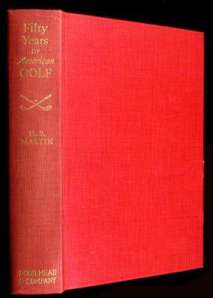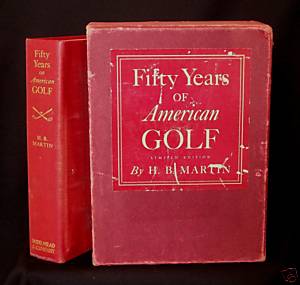Fifty Years of American Golf was published by Dodd, Mead in 1936 and written by H.B. Martin. The book was published in both a limited edition of 355 copies and a standard trade edition, in 1936. The limited edition version of the books was hand numbered and issued with a red slipcase, and each was signed by Martin. Not many of the slipcases can be found, so a copy with the original slipcase is considered rare.
Although Herbert Warren Wind would eclipse H.B. Martin in 1948 with his definitive History of American Golf, Martin’s work is still one of the most important in American golf history.
Harry Bromlaw “Dickey” Martin
H.B.’s full name was Harry Brownlaw Martin and he was a golf writer. Martin was an early ghost writer for Walter Hagen. In much the same way that O.B. Keeler was a sidekick of Bobby Jones, so H.B. Martin was for Walter Hagen. Period newspaper articles mention that Hagen and Martin would sail together on transatlantic ocean crossings. In addition to writing a golf column for The New York Globe at various times during his career Martin also wrote for The World and The American. His obituary in The New York Times in 1959 called him a leading authority on golf and said that at one time he was the publisher and editor of four golf magazines. He was also a founder of the P.G.A. in 1917. Records indicate he played to a handicap of twelve.
We went back and researched when Fifty Years of American Golf was originally published. The New York Times book review in 1936 gave it a positive review and noted that Martin writes with “real zest and a pleasant humor”. The original cost of the 423 page book was $5.

The book is organized into thirty chapters including “Golf Architects and Famous Courses” and a strong chapter on “The Hectic Twenties”. Partially, what makes this book so good is that Martin lived through the height of the golden age of golf course architecture and amateur golf. He knew many of the greatest architects and golfers as contemporaries and thus has unique insights into the game’s history.
The rare slipcase:

His well researched history gives plenty of in-depth detail. Pages 135-136 list all the golf clubs formed in the United States prior to 1895, a list we have always looked for, but couldn’t find. It lists over fifty clubs, many of which we found to be surprising. Those formed in the first five years are:
1888
St. Andrews, New York
1889
Tuxedo Club, New York
1890
Middlesboro Golf Club, Kentucky
Newport Golf Club, Rhode Island
Hotel Champlain Course, New York
1891
Shinnecock Hills, New York
Philadelphia Country Club, Bala, Pennsylvania
1892
Chicago Golf Club, Illinois
The Warren’s Farm Golf Club, Massachusetts
Baltimore Golf Club, Maryland
Powelton Golf Club, Newburgh, New York
As good as the writing is in the book, the black and white pictures from golf at the turn of the century through 1936 are each worth at least a thousand words. There are 168 pictures in the book, and each one is interesting. Most golf history books reprint the same pictures repeatedly. Martin’s book is quite interesting in that the early photographs are seldom seen in other books, even to this day. They tell a story of a formal gentleman’s game.
A reprint edition of Fifty Years of American Golf was printed in 1966 by Argosy-Antiquarian and was also issued with a slipcase. This edition of the book is more widely available than the 1936 original.
Other Books by Martin
Martin was also the author of Golf for Beginners in 1930, Golf Made Easy in 1932, Golf Yarns: the best things about the game of golf in 1913 and ten other titles, mostly focused on instruction. He was also the author of the important club history The Garden City Golf Club 1899-1949.
You must be logged in to post a comment.